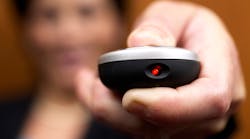This file type includes high resolution graphics and schematics when applicable.
Remote controls have traditionally utilized infrared (IR) technology. However, a change is now underway, as RF technology is increasingly being used in remote controls. In fact, according to industry estimates, almost 50% of TV and set-top-box remote controls currently entering the market are based on RF technology.
One company that is supporting the utilization of RF-based remote-control products is RedRat. The firm’s RF Module Evaluation Kit is intended for RF4CE and Bluetooth testing (Fig. 1). Manufacturers of set-top boxes and consumer electronics can take advantage of the evaluation kit’s components and software to allow RF testing scripts to be incorporated into current IR test processes. This capability enables evaluation before manufacturers and vendors move to a testing environment that is either mixed or fully RF-based.
With RedRat’s evaluation kit, set-top-box manufacturers can examine various factors associated with automated set-top-box control via RF protocols. Such factors include pairing with multiple boxes, the impact of interference in a test facility, and how rapidly commands can be sent. The company says its evaluation kit has been successfully incorporated into RF4CE and Bluetooth set-top-box testing environments of several large set-top-box manufacturers and broadband companies, both in the U.S. and Europe.
The evaluation kit contains a USB module adapter, which can be connected to a laptop or PC via USB. Both Windows and Linux operating systems are supported. Customers can also request Mac-compatible evaluation kits. Moreover, firmware updates are delivered via the RedRat Device Manager.
In addition, the evaluation kit contains an RF module for RF4CE and Bluetooth testing. RF4CE capability is enabled by Texas Instruments’ (TI) CC2533 system-on-a-chip (SoC) solution for 2.4-GHz IEEE 802.15.4 and ZigBee applications. The driving force behind the module’s Bluetooth capability is TI’s CC2564 dual-mode Bluetooth controller.
The kit also consists of evaluation software and associated scripting tools. The evaluation software includes a Windows “Toolbox” application to experiment with target discovery, pairing, and control (Fig. 2). Additional features include an HTTP REST application programming interface (API) for integration with third-party software, as well as a .NET API for direct use in third-party applications.
Although many newer set-top boxes utilize both IR and RF technologies, IR is expected to be phased out over time. With that being said, this evaluation kit appears primed to meet future needs in this arena.
RedRat Ltd., +44 1799 520092
This file type includes high resolution graphics and schematics when applicable.




